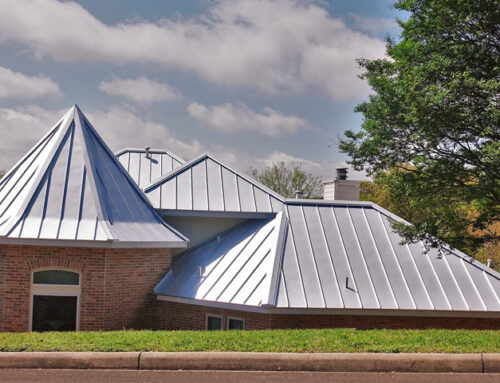Are flat roofs more likely to leak than pitched roofs? No, not when properly installed and maintained. While those might seem like big caveats, there are simple steps you can take to ensure that your flat roof is properly installed and then well-maintained. We’ll discuss what you should know about the potential of flat roofs to leak in both commercial and residential contexts below. Then we’ll give you steps to prevent flat roof leaks.
On Commercial Buildings
Most commercial buildings have flat roofs because pitched roofs would be too expensive or too heavy, given the size of the building. For most, pitched roofs are not a viable option to reduce leaks. That’s okay because you can get a flat roof that is properly waterproof and will prevent leaks for many years. Most of the concerns about leaks on flat roofs come from three things:
- Older roof types: Built-up roofing (BUR) was once the roof of choice on commercial buildings. BUR is much more likely to leak than newer roof options, like TPO and EPDM. Further, BUR is considerably more challenging to repair when it does develop leaks. You can avoid much of the leak risk and the hassle by investing in newer, better roof types (and ensuring you get the manufacturer’s best warranty.)
- Poor installation: We’re not just talking about roof installation. The proper installation of skylights, HVAC equipment and lighting protection systems all impact the performance of your roof. You want your roofer involved with all of these installs to make sure that they don’t disturb the integrity of your roof system.
- Poor maintenance: Commercial roofs need maintenance, or they develop leaks. However, some roof types need more maintenance than others. Be sure that you know and keep up with the maintenance of your specific roof needs.
On Homes
Many homeowners who are completing major renovations or building home additions choose to place a flat roof on top. While flat roofs are perfectly capable of performing well in residential contexts, there are two main things that undermine their quality and may cause leaks:
- Roof integration: When combining a flat roof with a pre-existing pitched roof, there is a lot of room for error. Roofers have to be meticulous about how they connect to the two surfaces, adding underlayment to the pitched component and directing water drainage off the flat roof properly. This is the most common spot for errors, so you want to ensure your roofer knows how to handle it.
- Roofer inexperience: Unfortunately, most residential roofers do not install flat roofing often, and their inexperience can lead to mistakes. Ideally, choose a roofer who also works on commercial properties, as they should have more experience with flat roofing.
Preventing Flat Roof Leaks
The most important thing you can do to prevent flat roof leaks is to work with a talented roofer that you trust to do a good job. Your roofer should give you specific recommendations for the best flat roof for your specific building or home. They should also show you how to keep up with maintenance.







